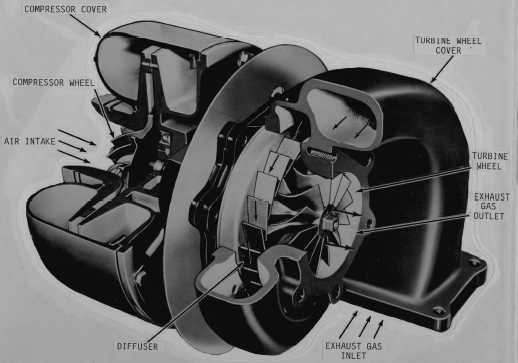Reassembly
After you have inspected, cleaned, and replaced worn or damaged parts, put the supercharger back together as prescribed in the manufacturer's maintenance and service manuals. Upon complete reassembly and after the supercharger is installed on the engine, add the proper quantity of recommended engine lubricating oil to the gear end plate through the pipe plughold.
TURBOCHARGERS
The turbocharger (fig. 5-38) is a unit that is driven by exhaust gas to force (charge) air into the diesel engine cylinders for more complete burning of fuel and to increase engine power. As with any air induction component, the turbocharger is subject to environmental situations that could result in a turbocharger failure.
The real problem lies not in fixing the failure but in determining the cause. Replacing a failed turbocharger without first determining why it failed will often result in a repeated failure.
There are many causes of turbocharger failure, but they can be grouped into the following categories:
Lack of lubricating oil
Foreign material or dirt in the lubricating system
Foreign material in either the exhaust or air induction system
Material or workmanship
A failure can occur if the lubricating oil being supplied to the turbocharger is not sufficient to lubricate the thrust and journal bearings, stabilize the journal bearings and shaft, and cool the bearing and journal surfaces, even for periods as short as 5 seconds.
Operating the engine with contaminated oil under the assumption that the oil filter will remove the contaminants before they reach the bearings of the turbocharger can be quite costly. Actually, there are certain conditions under which the oil filter is bypassed and, if the oil is contaminated, turbocharger damage can result. Some examples of instances where the filter will be bypassed areas follows:
The turbocharger lubrication valve is open as it is in starting.

Figure 5-38.-Turbocharger (cutaway view).
Continue Reading